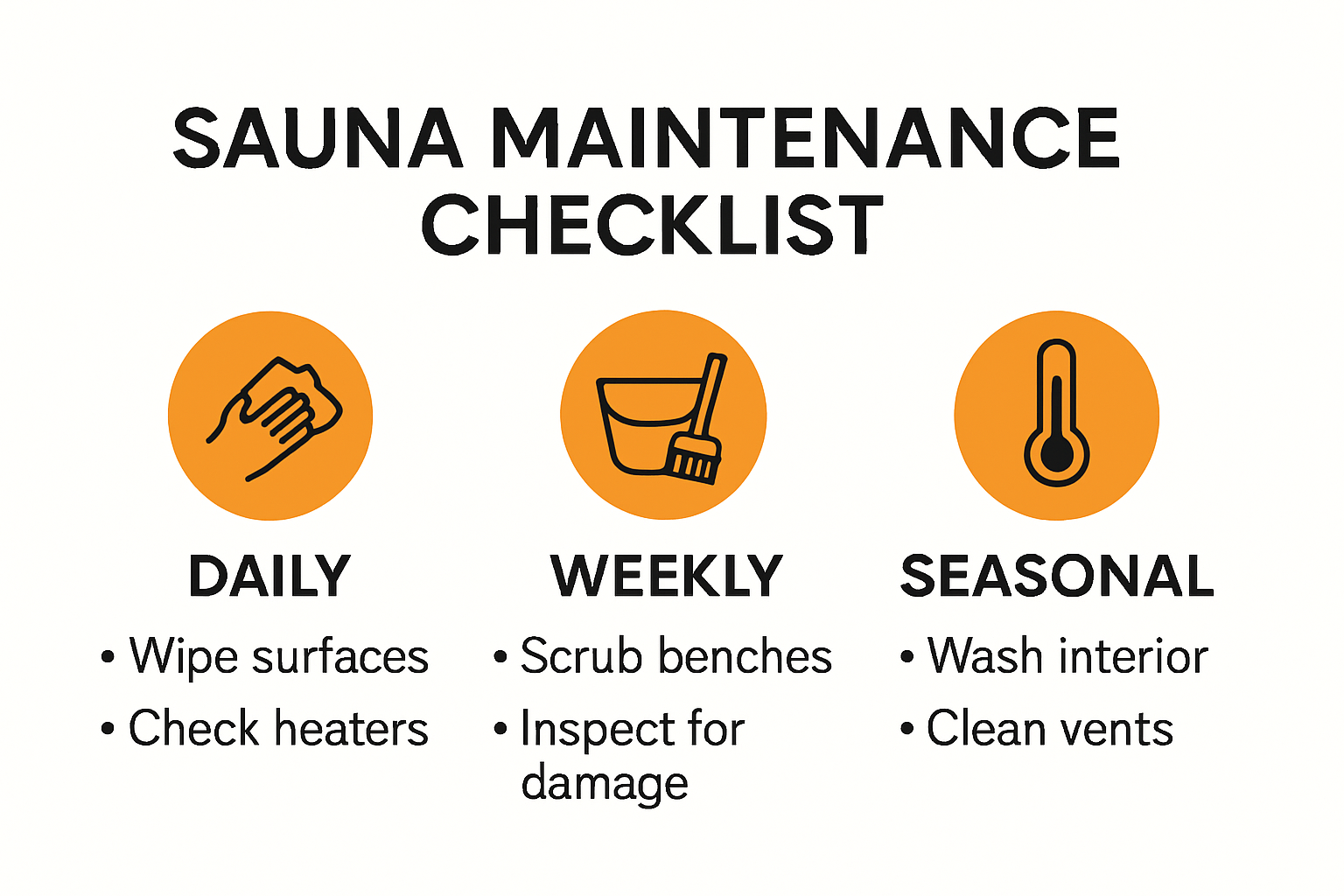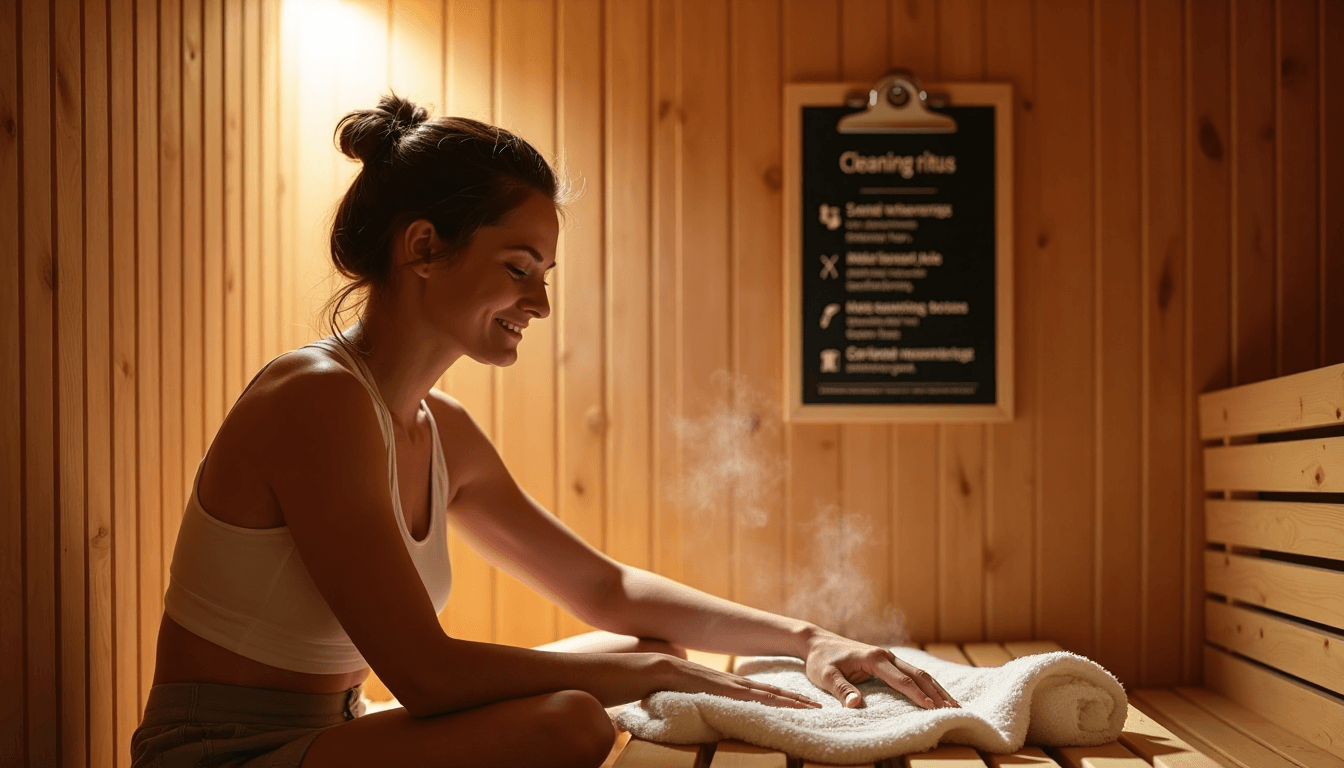
Sauna Maintenance Checklist 2025: Easy Steps for Clean Relaxation

Proper sauna maintenance might sound like a chore, but your health and investment depend on it more than you think. Here is the twist. Just wiping surfaces daily can cut down bacterial growth and extend your sauna’s lifespan by years. Most people overlook one detail though. The real secret to a clean, worry-free sauna is not expensive gadgets or hard-to-find products. It is smart, simple steps done on the right schedule.
Table of Contents
- Daily And Weekly Sauna Care Steps
- Monthly And Seasonal Deep Cleaning Tasks
- Preventing Common Sauna Issues
- Essential Sauna Safety And Longevity Tips
Quick Summary
| Takeaway | Explanation |
|---|---|
| Daily Cleaning | Wipe down all surfaces with a clean towel after each session to prevent moisture accumulation and bacterial growth. Leave the door open for 30-45 minutes post-use to allow moisture to evaporate. |
| Weekly Maintenance | Conduct a deep cleaning with mild, sauna-specific cleaners and inspect heating elements and sauna stones for wear. Monitor humidity levels with a hygrometer, keeping them between 10-20%. |
| Monthly and Seasonal Care | Perform thorough inspections of wood surfaces, heating elements, and ventilation systems; use wood oils or sealants for protection. Conduct professional inspections on electrical systems regularly. |
| Moisture Management | Maintain indoor humidity levels between 10-20% to prevent wood deterioration. Utilize dehumidifiers and ventilation systems to control moisture effectively. |
| Safety Protocols | Establish clear usage guidelines, including session duration and hydration. Regularly check fire safety measures and ensure strict clearance around heating elements. |

Daily Cleaning Rituals for Optimal Sauna Hygiene
Daily maintenance represents the foundation of sauna care. Immediate post-session cleaning prevents moisture accumulation, bacterial growth, and potential wood deterioration. After each sauna session, wipe down all surfaces with a clean, dry towel to remove sweat and moisture. According to American Sauna Society, this simple step can dramatically reduce bacterial proliferation and extend your sauna’s lifespan.
Ventilation plays a critical role in daily maintenance. Leave the sauna door open for 30-45 minutes after use, allowing residual moisture to evaporate completely. This practice prevents mold and mildew formation, which can compromise both the sauna’s structural integrity and your health. National Sanitation Foundation recommends thorough air circulation as a primary defense against microbial growth in humid environments.
Pay special attention to wooden surfaces. Use a soft, lint-free cloth to absorb any remaining moisture, working with the wood grain to prevent potential scratching or damage. If your sauna includes removable components like backrests or headrests, take them out and air them separately.

Weekly Deep Cleaning and Maintenance Procedures
Weekly maintenance goes beyond surface-level cleaning, addressing deeper hygiene and functional requirements. Start with a comprehensive surface cleaning using a mild, sauna-specific cleaner. Avoid harsh chemicals that might damage wood or leave residual odors. Indoor Sauna Professionals Association suggests using pH-neutral, wood-safe cleaning solutions that preserve the natural properties of your sauna materials.
Inspect your sauna’s heating elements and stones during weekly maintenance. Check for any signs of wear, cracking, or discoloration in the stones. Sauna stones are crucial for heat distribution and creating the right atmospheric conditions. If stones appear damaged or excessively worn, consider replacing them to maintain optimal performance.
Clean the floor thoroughly, paying attention to corners and less visible areas where moisture and debris might accumulate. Use a soft-bristled brush or microfiber mop to prevent scratching wooden surfaces. For infrared saunas, gently wipe down heating panels with a soft, dry cloth to remove dust without risking electrical components.
Maintaining proper humidity levels is another critical aspect of weekly care. Use a hygrometer to monitor moisture content, ensuring it remains within the recommended 10-20% range. This prevents wood warping and creates an environment less hospitable to mold and bacteria.
Consistent daily and weekly maintenance transforms your sauna from a simple wellness tool into a long-lasting, hygienic retreat. By dedicating just a few minutes after each session and conducting thorough weekly inspections, you’ll preserve your sauna’s quality, ensure optimal performance, and create a consistently refreshing experience.
Below is a table to help you easily differentiate the daily, weekly, monthly, and seasonal sauna care steps mentioned above and in following sections.
| Maintenance Frequency | Key Tasks | Focus Areas | Tools/Products Needed |
|---|---|---|---|
| Daily | Wipe all surfaces after each session, air out sauna | Surface cleaning, ventilation | Clean, dry towels, soft lint-free cloth |
| Weekly | Deep clean with sauna-specific cleaner, inspect stones & heaters, monitor humidity | Deep surfaces, heating elements, floors, humidity | pH-neutral cleaner, hygrometer, soft brush/mop |
| Monthly | Inspect all wood, clean hidden areas, replace worn stones | Wood preservation, detailed cleaning | Wood-safe cleaner, soft brush, replacement stones |
| Seasonal | Check joints/seals, treat wood, inspect ventilation & electrical | Structural health, wood treatment, safety inspection | Wood oil/sealant, dehumidifier, tools for inspection |
Monthly and Seasonal Deep Cleaning Tasks
Beyond daily and weekly maintenance, monthly and seasonal deep cleaning tasks are crucial for preserving your sauna’s performance, aesthetics, and longevity. These comprehensive care routines go far beyond surface cleaning, addressing structural integrity, wood preservation, and comprehensive system checks.
Comprehensive Monthly Cleaning Protocol
Monthly deep cleaning represents a critical maintenance checkpoint for your sauna. Start by conducting a thorough inspection of all wooden surfaces, looking for subtle signs of wear, discoloration, or potential moisture damage. Home Sauna Professionals Association recommends using specialized wood cleaners that maintain the natural protective properties of sauna timber.
Focus on hard-to-reach areas often overlooked during routine cleaning. Remove removable components like backrests and benches, cleaning them separately. Use a soft-bristled brush to gently remove accumulated dust and debris from corners, joints, and less accessible areas. Wooden surfaces require meticulous attention to prevent long-term degradation.
Heater and stone maintenance are paramount during monthly inspections. Carefully examine sauna stones for signs of cracking, discoloration, or excessive wear. According to International Sauna Research Center, stones that appear brittle or damaged can compromise heat distribution and potentially create safety risks. Replace stones that show significant deterioration to maintain optimal heating performance.
Seasonal Preservation and Structural Maintenance
Seasonal maintenance goes beyond cleaning, focusing on the sauna’s overall structural health. Every three to six months, conduct a comprehensive evaluation of wood joints, seals, and structural components. Look for potential signs of wood expansion, contraction, or subtle structural shifts that might indicate underlying moisture issues.
Wood treatment is a critical seasonal task. Apply a high-quality, sauna-specific wood oil or sealant designed to protect against moisture and UV damage. Wood Preservation Institute suggests using natural, breathable treatments that enhance wood’s inherent resistance to environmental stressors without creating a moisture-trapping barrier.
Ventilation systems require careful seasonal assessment. Check all ventilation points, ensuring they remain unobstructed and fully functional. Clean exhaust and intake vents thoroughly, removing any dust or potential blockages. Proper ventilation is essential for preventing moisture accumulation and maintaining a healthy sauna environment.
Electrical components and heating elements demand special attention during seasonal maintenance. Inspect electrical connections, looking for any signs of wear or potential hazards. For infrared saunas, carefully clean heating panels and verify that all electrical systems function correctly. Electrical Safety Foundation recommends professional inspection if you notice any unusual performance or potential electrical irregularities.
By implementing these monthly and seasonal deep cleaning strategies, you transform sauna maintenance from a reactive to a proactive approach. Each thorough inspection and careful cleaning session contributes to a more durable, efficient, and enjoyable sauna experience. Remember that consistent, comprehensive care is the key to preserving your wellness sanctuary for years to come.
Preventing Common Sauna Issues
Sauna ownership requires proactive problem prevention to maintain a safe, efficient, and enjoyable wellness environment. Understanding and addressing potential issues before they escalate can save significant time, money, and potential health risks.
Moisture and Structural Integrity Management
Moisture represents the most significant threat to sauna longevity and functionality. Wood deterioration begins with unchecked humidity, making comprehensive moisture management critical. National Wood Protection Association recommends maintaining indoor humidity levels between 10-20% to prevent wood warping, rot, and bacterial growth.
Implement strategic moisture control techniques. Use a high-quality dehumidifier specifically designed for wooden environments. Install moisture-resistant barriers in critical areas, particularly around heating elements and floor joints. Regularly inspect wood surfaces for early signs of water damage, such as discoloration, soft spots, or subtle warping.
Ventilation plays a crucial role in moisture management. Ensure your sauna has proper air circulation mechanisms. Indoor Air Quality Institute suggests creating a balanced ventilation system with both intake and exhaust points to facilitate continuous air exchange, preventing humidity accumulation and potential mold development.
Electrical and Heating System Safety
Electrical components require meticulous attention to prevent potential hazards. Electrical Safety Foundation emphasizes the importance of professional installation and periodic professional inspections. Sauna heating systems demand specialized maintenance to ensure safe, consistent performance.
Conduct quarterly electrical system checks. Look for signs of wear on power cords, verify grounding connections, and ensure all electrical components remain dry and free from corrosion. For infrared saunas, carefully inspect heating panels for any signs of damage or performance inconsistencies.
Heater rock maintenance is another critical prevention strategy. Replace sauna stones annually or when they show significant wear. Cracked or deteriorating stones can create uneven heat distribution and potential safety risks. Choose high-quality, heat-resistant stones specifically designed for sauna environments.
Wood Surface and Structural Preservation
Preserving wooden surfaces goes beyond aesthetic considerations. Proactive wood care prevents long-term structural degradation. Wood Preservation Research Center recommends periodic light sanding to remove minor surface imperfections and applying breathable, heat-resistant wood treatments.
Avoid common maintenance mistakes that can compromise wood integrity. Never use standard household cleaners or oil-based treatments that might emit toxic fumes when heated. Select specialized sauna wood treatments that maintain the natural properties of the timber while providing protection against environmental stressors.
Regular visual inspections can catch potential issues early. Look for signs of wood separation at joints, subtle cracks, or areas of discoloration. Address these minor imperfections promptly to prevent more extensive damage.
By implementing these comprehensive prevention strategies, you transform sauna maintenance from a reactive to a proactive approach. Each careful inspection, strategic intervention, and preventive measure contributes to a safer, more durable, and more enjoyable sauna experience. Remember that consistent, informed care is the key to long-term sauna performance and reliability.
The following table summarizes some of the most common sauna problems, their causes, and simple prevention strategies based on information in the preceding sections.
| Common Issue | Primary Cause(s) | Prevention Strategies |
|---|---|---|
| Wood Warping/Rot | High humidity, poor ventilation | Maintain 10-20% humidity, improve ventilation, use dehumidifiers |
| Mold/Mildew Growth | Moisture accumulation, inadequate air circulation | Wipe surfaces daily, air sauna after use, clean vents |
| Heater/Electrical Failures | Wear, corrosion, improper inspection | Quarterly inspections, keep components dry, professional checks |
| Uneven Heating/Stone Issues | Cracked/worn sauna stones, neglected replacement | Inspect and replace stones regularly, use heat-resistant stones |
| Wood Surface Damage | Harsh cleaners, improper products, neglect | Use sauna-safe cleaners, regular gentle sanding, apply wood treatments |
Essential Sauna Safety and Longevity Tips
Sauna safety and longevity extend far beyond routine maintenance. Understanding comprehensive safety protocols and implementing strategic preservation techniques ensures a secure, enduring wellness experience that protects both your investment and personal well-being.
Personal Safety and Operational Guidelines
Personal safety begins with understanding fundamental sauna usage principles. Hydration and time management are critical components of responsible sauna use. American Heart Association recommends limiting initial sauna sessions to 10-15 minutes, gradually increasing duration as your body acclimates. Always listen to your body and exit immediately if you feel dizzy, uncomfortable, or experience any unusual symptoms.
Establish clear operational guidelines for sauna use. Install clear, visible signage indicating maximum occupancy, recommended session duration, and essential safety instructions. Create a comprehensive user manual that outlines proper entry and exit procedures, appropriate clothing recommendations, and potential health contraindications. National Safety Council emphasizes the importance of providing clear, accessible safety information to prevent potential accidents.
Consider implementing additional safety features. Install emergency shut-off switches for heating elements, ensure robust handrails are securely mounted, and maintain non-slip surfaces. For home saunas, restrict access for children and individuals with specific health conditions without proper supervision.
Fire Prevention and Electrical Safety Protocols
Fire prevention represents a critical aspect of sauna safety. Electrical systems demand meticulous attention and professional oversight. Electrical Safety Foundation recommends annual professional inspections of all electrical components, focusing on heating elements, power connections, and potential wear points.
Maintain strict clearance protocols around heating elements. Remove all combustible materials and ensure a minimum safe distance between heaters and surrounding surfaces. Install high-quality fire extinguishers specifically rated for electrical and wood-based fires. Consider implementing automatic temperature shut-off mechanisms that activate if heating systems exceed safe operational parameters.
Regular electrical system checks are non-negotiable. Verify grounding connections, inspect power cords for signs of wear, and ensure all electrical components remain dry and corrosion-free. For infrared saunas, carefully examine heating panels and connections to prevent potential electrical hazards.
Structural Integrity and Long-Term Preservation
Preserving your sauna’s structural integrity requires a holistic approach that combines proactive maintenance with strategic interventions. Wood preservation is more than aesthetic maintenance. Wood Research Institute recommends periodic professional assessments to identify potential structural vulnerabilities before they become significant issues.
Implement a comprehensive documentation system. Maintain detailed records of all maintenance activities, repairs, and component replacements. This documentation not only helps track the sauna’s condition but also provides valuable insights for future maintenance strategies.
Consider environmental factors that might impact your sauna’s longevity. If located in areas with extreme temperature variations or high humidity, invest in additional protective measures such as specialized sealants, enhanced ventilation systems, and more frequent professional inspections.
By integrating these comprehensive safety and preservation strategies, you transform sauna ownership from a passive experience to an active, informed wellness journey. Each careful consideration, from personal usage guidelines to structural maintenance, contributes to a safer, more enduring sauna environment that supports your long-term health and relaxation goals.
Frequently Asked Questions
What are the daily maintenance tips for my sauna?
Daily maintenance includes wiping down all surfaces with a clean towel after each session to prevent moisture and bacterial growth. Additionally, leave the sauna door open for 30-45 minutes post-use to allow moisture to evaporate.
How often should I deep clean my sauna?
You should conduct a deep cleaning of your sauna weekly, using a mild, sauna-specific cleaner. This involves checking heating elements and sauna stones for wear, as well as cleaning the floors and ensuring humidity levels remain between 10-20%.
What monthly tasks should I perform for sauna maintenance?
Monthly tasks include inspecting all wooden surfaces for wear or damage, cleaning hard-to-reach areas, and examining the heater stones for signs of cracking or excessive wear. It’s also a good time to apply wood treatments for preservation.
How can I prevent moisture-related issues in my sauna?
To prevent moisture-related issues, maintain indoor humidity levels between 10-20%. Utilize dehumidifiers, ensure proper ventilation, and regularly inspect wood surfaces for any early signs of water damage.
Experience Worry-Free Sauna Maintenance with Premium Solutions
Are you tired of battling constant moisture issues, wood deterioration, or the hassle of deep cleaning that never feels quite enough? The article has shown that regular cleaning routines, reliable accessories, and structural care are crucial for protecting both your health and your investment. But keeping up with daily, weekly, and seasonal steps can feel overwhelming, especially if your current setup is missing the right tools or quality materials.

Now is the perfect time to make sauna upkeep effortless so you can focus on relaxing. Best Life Sauna offers a full selection of premium saunas and carefully chosen wellness accessories designed for easy ongoing maintenance. From innovative infrared and traditional models to high-performance accessories and cold plunge tubs, you’ll find solutions tailored to every need. Start exploring Best Life Sauna today and discover how stress-free sauna ownership can be. Your sanctuary deserves the best — secure cleaner, safer, and longer-lasting results now.

